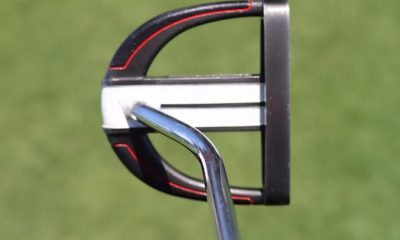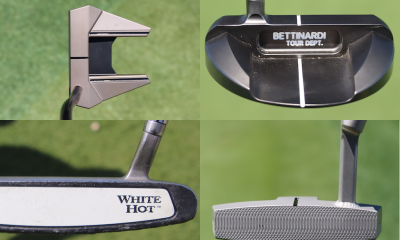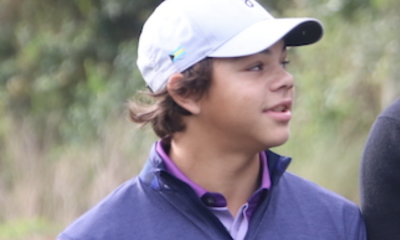Left Arm Bend: The Difference Between PGA Tour Players and Amateurs
We get questions about the left arm (or right arm for you lefties) during the swing… should it stay straight or should it bend? Many times our amateur clients have been told they “collapse” at the top, so they try the opposite of collapsing, which is keeping that left arm ram-rod straight. Well… neither is going to help your swing.
Let’s take a look at how the pros do it.
- LIKE100
- LEGIT20
- WOW11
- LOL8
- IDHT5
- FLOP16
- OB6
- SHANK97
Instruction
Clement: Laid-off or perfect fade? Across-the-line or perfect draw?

Some call the image on the left laid off, but if you are hitting a fade, this could be a perfect backswing for it! Same for across the line for a draw! Stop racking your brain with perceived mistakes and simply match backswing to shot shape!
- LIKE0
- LEGIT0
- WOW0
- LOL0
- IDHT0
- FLOP0
- OB0
- SHANK1
Instruction
The Wedge Guy: The easiest-to-learn golf basic

My golf learning began with this simple fact – if you don’t have a fundamentally sound hold on the golf club, it is practically impossible for your body to execute a fundamentally sound golf swing. I’m still a big believer that the golf swing is much easier to execute if you begin with the proper hold on the club.
As you might imagine, I come into contact with hundreds of golfers of all skill levels. And it is very rare to see a good player with a bad hold on the golf club. There are some exceptions, for sure, but they are very few and very far between, and they typically have beat so many balls with their poor grip that they’ve found a way to work around it.
The reality of biophysics is that the body moves only in certain ways – and the particulars of the way you hold the golf club can totally prevent a sound swing motion that allows the club to release properly through the impact zone. The wonderful thing is that anyone can learn how to put a fundamentally sound hold on the golf club, and you can practice it anywhere your hands are not otherwise engaged, like watching TV or just sitting and relaxing.
Whether you prefer an overlap, interlock or full-finger (not baseball!) grip on the club, the same fundamentals apply. Here are the major grip faults I see most often, in the order of the frequency:
Mis-aligned hands
By this I mean that the palms of the two hands are not parallel to each other. Too many golfers have a weak left hand and strong right, or vice versa. The easiest way to learn how to hold the club with your palms aligned properly is to grip a plain wooden ruler or yardstick. It forces the hands to align properly and shows you how that feels. If you grip and re-grip a yardstick several times, then grip a club, you’ll see that the learning curve is almost immediate.
The position of the grip in the upper/left hand
I also observe many golfers who have the butt of the grip too far into the heel pad of the upper hand (the left hand for right-handed players). It’s amazing how much easier it is to release the club through the ball if even 1/4-1/2″ of the butt is beyond the left heel pad. Try this yourself to see what I mean. Swing the club freely with just your left hand and notice the difference in its release from when you hold it at the end of the grip, versus gripping down even a half inch.
To help you really understand how this works, go to the range and hit shots with your five-iron gripped down a full inch to make the club the same length as your seven-iron. You will probably see an amazing shot shape difference, and likely not see as much distance loss as you would expect.
Too much lower (right) hand on the club
It seems like almost all golfers of 8-10 handicap or higher have the club too far into the palm of the lower hand, because that feels “good” if you are trying to control the path of the clubhead to the ball. But the golf swing is not an effort to hit at the ball – it is a swing of the club. The proper hold on the club has the grip underneath the pad at the base of the fingers. This will likely feel “weak” to you — like you cannot control the club like that. EXACTLY. You should not be trying to control the club with your lower/master hand.
Gripping too tightly
Nearly all golfers hold the club too tightly, which tenses up the forearms and prevents a proper release of the club through impact. In order for the club to move back and through properly, you must feel that the club is controlled by the last three fingers of the upper hand, and the middle two fingers of the lower hand. If you engage your thumbs and forefingers in “holding” the club, the result will almost always be a grip that is too tight. Try this for yourself. Hold the club in your upper hand only, and squeeze firmly with just the last three fingers, with the forefinger and thumb off the club entirely. You have good control, but your forearms are not tense. Then begin to squeeze down with your thumb and forefinger and observe the tensing of the entire forearm. This is the way we are made, so the key to preventing tenseness in the arms is to hold the club very lightly with the “pinchers” — the thumbs and forefingers.
So, those are what I believe are the four fundamentals of a good grip. Anyone can learn them in their home or office very quickly. There is no easier way to improve your ball striking consistency and add distance than giving more attention to the way you hold the golf club.
More from the Wedge Guy
- The Wedge Guy: Golf mastery begins with your wedge game
- The Wedge Guy: Why golf is 20 times harder than brain surgery
- The Wedge Guy: Musings on the golf ball rollback
- LIKE86
- LEGIT13
- WOW6
- LOL1
- IDHT0
- FLOP4
- OB1
- SHANK8
Instruction
Clement: Stop ripping off your swing with this drill!

Not the dreaded headcover under the armpit drill! As if your body is defective and can’t function by itself! Have you seen how incredible the human machine is with all the incredible feats of agility all kinds of athletes are accomplishing? You think your body is so defective (the good Lord is laughing his head off at you) that it needs a headcover tucked under the armpit so you can swing like T-Rex?
- LIKE0
- LEGIT2
- WOW2
- LOL0
- IDHT0
- FLOP0
- OB0
- SHANK2
-

 19th Hole2 weeks ago
19th Hole2 weeks agoDave Portnoy places monstrous outright bet for the 2024 Masters
-

 19th Hole3 days ago
19th Hole3 days agoJustin Thomas on the equipment choice of Scottie Scheffler that he thinks is ‘weird’
-

 19th Hole2 weeks ago
19th Hole2 weeks agoTiger Woods arrives at 2024 Masters equipped with a putter that may surprise you
-

 19th Hole3 days ago
19th Hole3 days ago‘Absolutely crazy’ – Major champ lays into Patrick Cantlay over his decision on final hole of RBC Heritage
-

 19th Hole2 weeks ago
19th Hole2 weeks agoTwo star names reportedly blanked Jon Rahm all week at the Masters
-

 19th Hole1 week ago
19th Hole1 week agoReport: LIV Golf identifies latest star name they hope to sign to breakaway tour
-

 19th Hole1 week ago
19th Hole1 week agoNeal Shipley presser ends in awkward fashion after reporter claims Tiger handed him note on 8th fairway
-

 19th Hole1 week ago
19th Hole1 week agoBrandel Chamblee has ‘no doubt’ who started the McIlroy/LIV rumor and why























Stephen Finley
Jan 16, 2018 at 7:41 pm
This can simply be the difference between less tension or rigidity (in the pro) versus more tension and rigidity, not to mention a misconception from the get-go. I used to teach, and I never told anybody to keep a ramrod-straight left arm. I used to talk about “comfortably extended” at most, but really I didn’t even want people thinking about it. Better to think about the curvature of the arc, path and plane, and being reasonably wide, with the body supporting the motion of the arms and club. You’ll notice in the sequence in the video, the takeaway shot of pro versus amateur (2:29) already shows the pro’s shoulders and upper body supporting the swinging away of the arms and club better than the amateur’s.
Jim
Jan 10, 2018 at 11:34 am
The analysis is interesting but has no instructional value. The reason is that the best ball strikers and longest hitters on tour all straighten their left arm at impact and also extend the left arm down the line after impact. Examples include Adam Scott, Dustin Johnson, Tiger, and Jason Day. There is simply no other way to achieve maximum power and consistency. Some players with superior timing do well with bent left arms at impact (eg, Lee Westwood and Jordan Speith) but in doing so sacrifice distance and accuracy. The importance of a straight left arm at impact is nothing new: Bobby Jones, Sam Snead and Jack Nicklaus all talked about it.
Deez
Dec 21, 2017 at 3:44 pm
This stuff is awesome. Whether the commenters would like to admit it or not, even in a sport almost completely based on skill, there are still genetic/physical limitations that hold back your potential. The more you can learn about the how the best players in the world move bio-mechanically, the easier it should be to realize what physical limitations might be causing your swing flaws.
AMG
Dec 21, 2017 at 5:37 pm
Thanks, Deez. The intent with this series was to finish with a large collection of comparison swing elements as a broad reference to the difference between how the best do it and what we can apply to our own swings when applicable. Thanks for watching!
JimN
Dec 20, 2017 at 6:59 pm
I think you may be focusing on the wrong arm. I see a greater difference in the right elbow than the left. For me, that flying right elbow puts me in a great position to ‘arm wrestle’ my shot into submission, typically ending in a nasty hook.
AMG
Dec 21, 2017 at 5:35 pm
The right arm is definitely important, Jim. The guys GolfWRX already have our right arm video which should be released in the next week or two. Thanks for taking the time to watch and comment!
DaveyD
Dec 20, 2017 at 9:58 am
Regardless of what 3D models show, if my swing works for me, it’s largely based on what my body lets me do. I’m not interested in getting injured just because I decided to move my arm angle a few degrees because of videos like this.
MarkH
Dec 15, 2017 at 10:41 am
The Difference?
Amateurs have homemade swings… most pros had and still have swing coaches.
James
Dec 14, 2017 at 9:41 am
AMG?? That logo???? How have you not gotten a cease and desist order from MB? Blatant ripoff.
Anthony
Dec 9, 2017 at 5:58 am
This is BS. It completely depends on the golfer and how it affects delivery etc!
Mark
Dec 20, 2017 at 2:50 am
Anthony this guy is the definition of simple minded. Many many different functional matchups to play golf at a high level.
Nutz
Dec 21, 2017 at 3:52 pm
Simple minded? The vast majority of players on the PGA tour are in very similar positions throughout the swing. There’s a reason Furyk is known for having a weird backswing; cause its not common among the best players in the world. But even in Furyk’s case I would be willing to bet that halfway through the downswing he looks like almost every other player on the PGA tour.
Fact is there are certain positions you need to be in during the swing to be a VERY good golfer. You can either accept it and try to change, or just accept mediocrity
Someone
Dec 8, 2017 at 5:10 pm
I think there is a very huge difference at 2:30 at the top of the swing. part of the reason the am has more elbow bend is because you can clearly see how much wrist hinge is in the left hand. The pro is only holding and maintaining the angle on the way up where as the am is taking it inside and tight; you can also tell that the am is taking it basin them based on how much the right arm is bending and folding BEHIND him, whereas the pro still has it rather outside his body.
If i had to guess, with the lack of hinge at the top that maybe the pro was jason day…It is similar to jb holmes at the top where he is just holding the angle rather than making it smaller, but i wouldn’t say it’s holmes simply because holmes doesn’t take the club back as far. But just my guess…
Anyhow, i think the wrist hinge plays a huge role in whether or not the left arm can remain “straight” throughout the swing. it seems obvious that keeping it straight is not true since there is obviously some bending going on here. perhaps the “keep the left arm straight” was a lesson from old teaching days where they knew they couldn’t keep their arm straight but by consciously trying to do so, it would get their left arm in a better position through the entire swing. They didn’t have the same equipment we have these days, so it makes sense how t could be a possible explanation for the “left arm straight” guidance.
AMG
Dec 14, 2017 at 1:56 am
Well said.
Bob Jones
Dec 8, 2017 at 4:29 pm
Let your left arm hang straight down. That is its natural shape. Now keep that shape when you address the ball and throughout your swing. No need to make it ramrod straight like Ben Hogan made his. It’s YOUR left arm, do what’s natural with it for you.
Tom54
Dec 8, 2017 at 2:07 pm
Funny how your amateur you chose to depict says he is making it a point to keep his left arm straight throughout his swing. Maybe that’s why it’s hyper extended before impact. Trying to keep it straight tightens the shoulder. Maybe that’s why his impact looks so different. I didn’t see as much of a chicken wing as described. I think some bending is natural as long as it’s not too severe. Nice to see the subtle differences though in your video
Mr. Divot
Dec 8, 2017 at 1:06 pm
Good video. Shows me what I need to adjust. Appreciated. I noticed a big difference in their wrist positions at the top of the swing too. Bottom of the pro’s wrist seemed much more inline with the bottom of his forearm, where as the Amateur cocked his wrist perhaps in an effort to get his club further back. Would you agree with this?
JTG
Dec 8, 2017 at 11:27 am
So now that we know we need to keep the left arm straighter…. how do we make that happen? IS there a follow up that shows exercises or drills to help? Or is that just a point of information?
AMG
Dec 8, 2017 at 5:02 pm
We have an entire series of drills planned to release throughout the winter.
Chris
Dec 7, 2017 at 4:28 pm
Lee Westwood?
AMG
Dec 7, 2017 at 4:43 pm
No sir, not Lee Westwood.
Patricknorm
Dec 7, 2017 at 12:48 pm
I’m a left handed golfer with a permanently bent right arm from a football injury.. When I was a teenager I was tackled hard on Astro turf ( football) on my right elbow. This elbow is bent about 20 degrees. Clearly this affects my distance because my lever is a shorter. My compensation as per my instructor is that I’m about 75% accurate for fairways and greens. I play to a 7.9 factor ( index).
My bent elbow isn’t as severe as Calvin Peete’s was but, it’s close. I’ve looked into surgery but each surgeon I’ve talked with said it’s not that bad. However, there are times when the bent elbow hurts a lot.
If you saw my swing on video it doesn’t look that bad but I know I’m compensating , regardless. I would guess, based on tournament play, I’m giving up 15-25 yards off the tee . I think if I were 20 years old I’d be a mirror of the amateur in the video ( without bent elbow).
Excellent video by the way. I know there has always been discussion about Jordan Spieth’s slightly bent left elbow.
AMG
Dec 7, 2017 at 4:55 pm
It sounds like the other parts of your game are pretty solid to post those scores which is great!
Two pros come to mind that we’ve measured that have a pretty good bit of flex/bend in that lead arm in the downswing. Would not consider that element by itself in any way a swing flaw. Jordan would be a great example.
Andrew Cooper
Dec 7, 2017 at 12:40 pm
Thanks for sharing this info. Could you elaborate on the 3.6 hyper-extension in the pro’s set up?
AMG
Dec 7, 2017 at 4:50 pm
It’s not uncommon to see their left arms fairly straight but with more bend in the right arm, and almost the opposite trend with ams. We’re working on a right arm video that will go into more detail about that. Did that address what you were asking about?
Andrew Cooper
Dec 7, 2017 at 6:36 pm
Thanks, I appreciate the reply. Yes I would’ve thought fairly straight, but just surprised that it would be hyper-extended, which I take as meaning bent beyond normal range of motion. Anyhow, enjoying your videos, some great info.
jim
Dec 6, 2017 at 11:48 pm
Shall we assume that the pro and good amateur are anatomically identical? If not then the comparison is flawed.
As for the ‘chicken wing’ followthru …. Jamie Sadlowski anybody?!!
Branson Reynolds
Dec 6, 2017 at 10:24 pm
The video has an okay idea, but a 1:1 sample size is crazy. It’d be a lot more useful to have at least 10 of each.
AMG
Dec 6, 2017 at 11:55 pm
The data sample size was actually much larger than 10 of each. We chose the pro and the am in the video because they represented each sample size. The video would have to be much longer to show each and every golfer’s collected data. This is not a comparison of 1 pro to 1 am, but a representation of each group using these two golfers.
AMG
Dec 7, 2017 at 11:22 am
Is Jamie Sadlowski anatomically identical to the am or any other golfer? Can you see why we don’t just apply that criteria to looking at golf swings. None of our pros are anatomically identical, but all the ones we have data on do not hyper extended their left arm… neither does Jamie Sadlowski 😉
jim
Dec 7, 2017 at 4:54 pm
Thanks for your response to my query above. Before you can launch a comparative study between pro and amateur golfers on their lead arm biomechanics, you should first anatomically study their lead arm structure.
You can’t just take a group of pros and amateurs, examine their swing mechanics and then conclude their lead arm mechanics are different. You must determine why it’s happening.
PineStreetGolf
Dec 6, 2017 at 3:33 pm
This is actually a pretty good video that WRX kinda ruined by giving it a clickbait title.
The most important difference between pros and ams is the ability to throw weight and center of gravity down the target line without losing balance or spine angle. This video is a good one, though, especially for the short game.
If they had titled it “A helpful tip, especially close to the hole, to get cleaner contact” it would have been great. Its not the difference between pros and ams.
Bob Jacobs
Dec 6, 2017 at 2:53 pm
Might just be me, but at least from the pics, I couldn’t see a discernible difference between pros and ams. Was also very confusing for me to hear about X degrees of bend in an elbow because my elbows dont bend!!
JEC
Dec 6, 2017 at 1:52 pm
Why do instructors keep trying to compare what Pros and Ams do in the golf swing? This is why most golf instruction doesn’t help make the weekend golfer any better.
stevek
Dec 14, 2017 at 3:27 pm
It’s because they only study static pictures and postures with no knowledge of Newtonian physics which provides a Dynamic analysis through Kinematics and Kinetics.
IOW, virtually all golf instructors depend on their subjective observations with no objective proof.
It’s changing slowly with the use of Trackman, 3D video, force plates, and a proper college education.